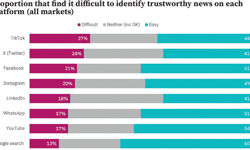
Q: How can AI help with personalisation?
A: AI is not just about existing processes getting faster. Personalisation raises exciting questions for our industry: how can we use AI to deliver innovative and more engaging experiences to audiences?
A lot of the press surrounding AI paints it as yet another wave of disruption in an already beleaguered industry. That said, personalisation gives me hope that AI can actually help us deliver differentiated, relevant reader experiences. Readers increasingly expect flexibility from their content – engaging with information when they want it, how they want it. Most personalisation efforts today are about content recommendation or format adaptation.
- Content: A reader can be served different stories on their homepage depending on their behaviour. Someone who typically reads more about sport could have stories about Euro 2024 pushed to them more proactively. Algorithms dynamically update the user experience, showing them what to read next.
- Format: The same story can now be repackaged in numerous ways to meet a reader’s needs. A reader can consume the same information in multiple ways, switching between auto-generated audio, video reels or bullet-point summaries. This makes the content more accessible to a broader range of readers. Some publications are even creating chat-bot experiences, where readers can interrogate information via dialogue. For example, at the FT, we created AskFT, a generative AI tool that answers subscribers’ questions in real-time by searching through our archives.
Q: What will be possible in the future?
A: With the current pace of innovation ‘the future’ may be only a few months away! The latest demo of GPT-4o and Google’s project Astra showed rapid progress in voice agents.
We’ve seen multiple agents in conversation with each other in recent demos. Perhaps, eventually, a news publication’s agent will talk to your personal agent to get you the information you need: “Good morning, we need to know any developments for the General Election. Please can you send this as a text message in bullet point form so that Bob can read it on his way to his meeting?” In this scenario, agents act like personal assistants, taking care of all personalisation. The user is removed completely from the process until the point of consumption.
It’s hard to say where the limits of personalisation with AI can go. Will we reach personalisation fatigue? More likely, I think readers will grow to expect a level of format flexibility and I think smartphones or personal devices will take on a larger role in making that happen.
Longer term, these developments could mean that most content and format personalisation will take place via platform providers versus by publishers themselves. This could help smaller newsrooms who cannot afford to develop in-house. That said, larger publications who have recently signed deals with OpenAI will likely receive special privileges. If most user interaction and personalisation is being delivered on other platforms, there is a risk that the news industry is reduced to a mere information supplier. Yet, there is an opportunity for news companies to gather valuable customer data through these agent interactions, feeding this back into the product discovery process.
Three top tips
- Ask: what user need does this solve? Sometimes, when we start experimenting with AI and personalisation we do things just because they are possible. If you start investing time and money in a project, it’s important to have a clear business case for why you think readers need it. The question for any personalisation project is: will this drive engagement over the longer term? (note: some formats may actually result in less time-on-page but more loyalty longer-term.) Select 2-3 metrics to track for any experiment to prove the value to the end user.
- Look out for unintended consequences. Hyper-personalisation comes with risks to consider. In a personalised feed, are major news stories like elections / extreme weather still reaching readers? Are readers receiving a balanced enough set of perspectives or is extreme curation reinforcing echo chambers and discouraging diversity of thought? Has reformatting resulted in a loss of depth or context that renders the story less useful, or even misleading?
- Be inspired by other industries. It is helpful to look beyond publishing for examples of user engagement. Think about personalisation in your own life – what apps do you use daily (eg. music, personal finance)? Have they developed any new experiences that you particularly enjoy? Talk to friends and family about AI-enabled experiences they are having and whether or not this added value to their experience. Remember that AI might not always be visible. It’s unlikely that most users will be aware that a product feature is AI-enabled so it may be more useful to talk in terms of user journey and experience.
Aliya and the other contributors to our AI Special took part in an ‘AI Special – Q&A’ webinar on Wednesday, 26 June. You can watch the recording by registering here.

About us
FT Strategies is the specialist media consultancy from the Financial Times. Drawing on the FT’s success publishing content read by millions, lessons learned transitioning to a customer-centric revenue model and our team’s experience from top media organisations, we’ve helped 700+ clients tackle strategy, revenue growth, newsroom operations and technology challenges.
Email: ftstrategies@ft.com
LinkedIn: www.linkedin.com/company/ftstrategies
Web: www.ftstrategies.com
This article was included in the AI Special, published by InPublishing in June 2024. Click here to see the other articles in this special feature.










